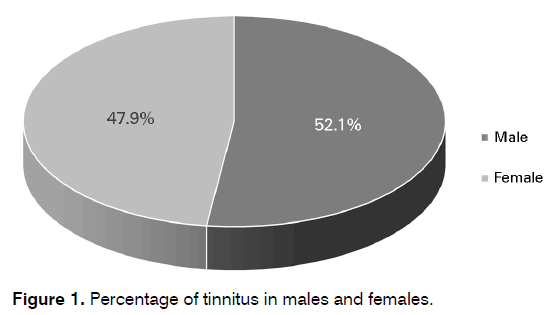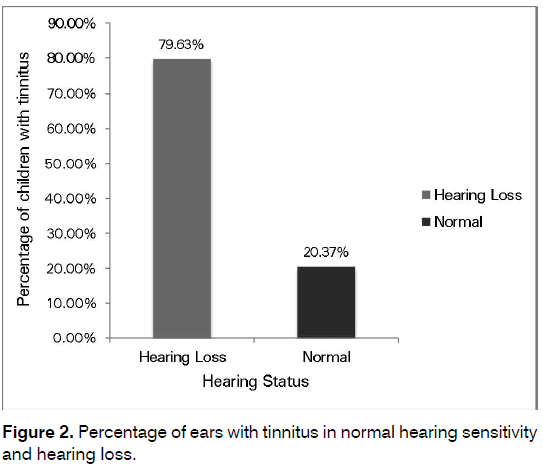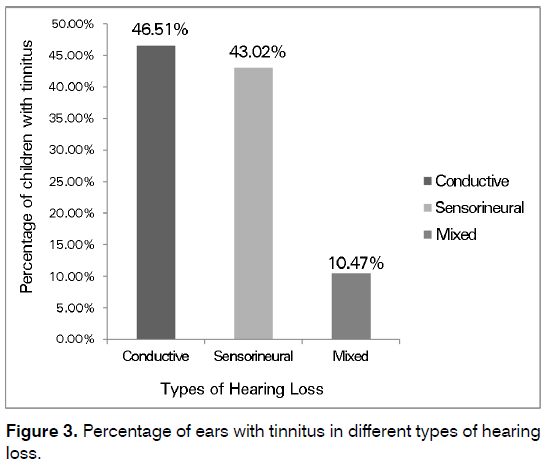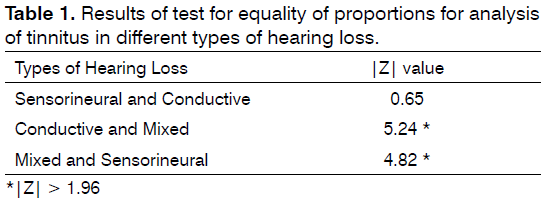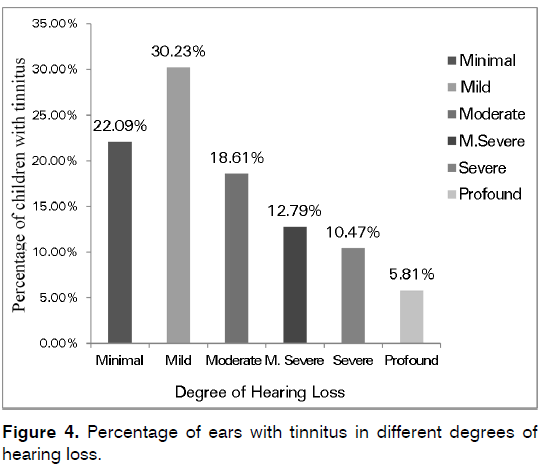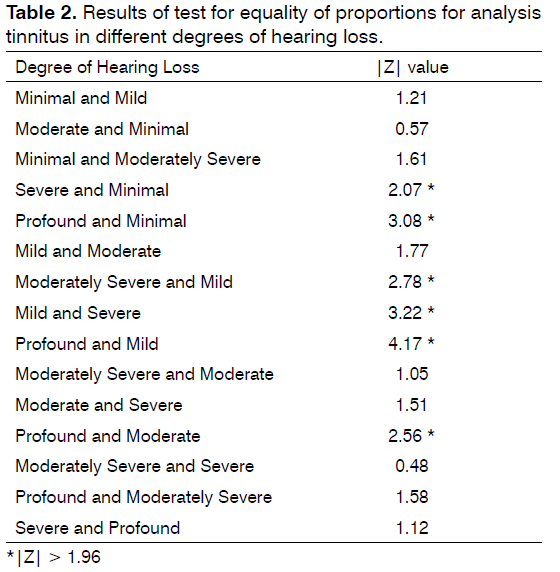The International Tinnitus Journal
Official Journal of the Neurootological and Equilibriometric Society
Official Journal of the Brazil Federal District Otorhinolaryngologist Society
ISSN: 0946-5448

Google scholar citation report
Citations : 12717
The International Tinnitus Journal received 12717 citations as per google scholar report
The International Tinnitus Journal peer review process verified at publons
Indexed In
- Excerpta Medica
- Scimago
- SCOPUS
- Publons
- EMBASE
- Google Scholar
- Euro Pub
- CAS Source Index (CASSI)
- Index Medicus
- Medline
- PubMed
- UGC
- EBSCO
Volume 19, Issue 2 / December 2015
Research Article Pages:33-38
One-year prevalence and risk factors of tinnitus in children with otological problems
Authors: Kumaran Thirunavukkarasu; Chinnaraj Geetha
PDF
Abstract
Introduction: The present study was conducted to find one year prevalence and risk factors of tinnitus in the children (below 18 years) who reported with the ear or hearing related complaint to All India Institute of Speech and hearing, Mysore.
Methods: A retrospective case analysis was carried out by reviewing the case files of those who visited the institute during the above period.
Results: The results shown that the tinnitus prevalence was 5.24%. No gender difference was found in children with tinnitus. Further, 79.63% of the children with tinnitus had hearing loss. In addition, 30.23% of the children with tinnitus had mild degree of hearing loss followed by minimal, and moderate degree of hearing loss. Most of these children had conductive, and sensorineural type of hearing loss than mixed type of hearing loss.
Conclusion: It can be concluded that hearing loss, gender, giddiness, and headache were found to be major risk factors.
Keywords: tinnitus, adult children, prevalence
Introduction
Tinnitus is defined as a sound perceived by the ears or head without any relationship to external source.Tinnitus is a common symptom in adult listeners. However, tinnitus is ignored by most of the children, particularly children with hearing loss[1]. Children have a tendency of not complaining about tinnitus may be due to the reason that they do not realize. It is an abnormal phenomenon, in addition, they may have grown habituated or personalized to it as tinnitus has been present for a long time [2,3]. Even though tinnitus is ignored by children, there are still reports on various inconvenience in their life like emotional distress, difficulty in concentration, learning deterioration, stress, behavioural disorders, fatigue, irritation, speech disorders, sleep disturbances, and poor attentiveness[4,5].
According to the earlier epidemiological studies in children with tinnitus, the prevalence of tinnitus was 15% in the school-age children with normal hearing sensitivity[6]. Holgers, estimated that 13% of children with normal hearing sensitivity had complaint of tinnitus[7]. Compared to children with normal hearing sensitivity, the prevalence rate high in children with hearing loss, that is, 55% of children with hearing loss at the age range of 11 to 18yrs have reported of tinnitus[8]. In a study done by Graham & Butler, the tinnitus prevalence rate was 66% in children with mild to moderate hearing loss and 29% in children with severe to profound hearing loss[9]. Mills & Cherry’s study found a prevalence rate of 29.5% and 43.9% in the 5-15 years old children with sensorineural and conductive hearing loss, respectively[10]. Viani also found similar results in the children with hearing problem at the age range of 6 to 17 years[11]. Graham found 64% of moderately severe hearing loss children at the age range of 12 to 18 years old reported tinnitus and, of these, 30% complained tinnitus as very troublesome [12].
The figures of prevalence have been presented in many nations across globe. However, India has the very small amount of information about the tinnitus prevalence and accompanying risk factors. A survey was conducted by Sreeraj et al. to find out the prevalence of communication disorders. They have done a survey in Mandya district of Karnataka state, India. They used high risk register during survey to find the prevalence of communication disorders. Based on their study, the prevalence of tinnitus was 9.6% in all age groups. They had found more number of adults as well as females had tinnitus[13]. However, they did not provide any information about the children with tinnitus and risk factors accompanying the tinnitus in children.
In India, prevalence of hearing loss is higher and the common causes of hearing loss are otitis media, genetic factors and sociocusis due to the environmental noise[14] and other systemic diseases, so the tinnitus prevalence also could be more. The tinnitus prevalence could be more in children with ear and hearing related problems. For the better rehabilitation programs, evidence on tinnitus prevalence and the accompanying risk factors are necessary. Even Coles et al. had highlighted that to develop rehabilitation programs or research on any condition, the prevalence data are mandatory[15]. Hence, the prevalence of tinnitus and the accompanying risk factors are necessary to develop assessment protocols, appropriate infrastructure, and rehabilitation strategies for tinnitus. According to the reports of Hall et al. the risk factors accompanying tinnitus provide a lot of information regarding proper prevention campaigns[16]. Hence, information about the prevalence and the risk factors of tinnitus are important.
Hence, the present study attempted to study ‘the prevalence of tinnitus in children (below 18 years of age). The objectives of the present study were to find the prevalence and risk factors of tinnitus in children with the complaint of ear and/or hearing to the All India Institute of Speech and Hearing, Mysore, between July 2012 and June 2013, and to compare the same across gender, degree and types of hearing loss, and analyse other possible risk factors associated with tinnitus.
Method
To find the tinnitus prevalence and risk factors in children with otological complaints, the case files of children below 18 years were reviewed. Retrospective assessment of the case files of the clients who visited the institute between July 2012 and June 2013 was done.
The OPD register was used for the retrospective assessment. From the OPD register, the number of children visited the institute, their age range, gender and the number of children who reported of tinnitus were noted down. The case files of children who reported of tinnitus were retrieved. From the case files the primary and secondary complaint of the children, age, gender, and medical histories were noted down.
The audiological profile of children with tinnitus were also taken, if they underwent audiological evaluation. For hearing evaluations standard procedures and testing conditions were followed by the Department of Audiology. The complete hearing evaluations were conducted in the sound treated double room set up. Calibrated diagnostic audiometers and middle ear analysers were used for the routine hearing evaluations. Routine hearing evaluation comprises of pure tone audiometry, speech audiometry and Immittance evaluation for children who could be conditioned.
The standard procedures include obtaining pure tone thresholds using the modified version of the Hughson and Westlake procedure in the audiometric frequencies[17]. Live voice used with a standardized speech materials in the listener’s mother tongue to find the speech recognition and identification scores of speech audiometry for older children and speech detection threshold for Younger children. For very young children Auditory Brainstem Response (ABR) and Oto Acoustic Emission (OAE) are included in the protocol. Tympanometry and acoustic reflex thresholds are done as a part of Immittance evaluation.The interpretation of the results of the above tests and the provisional diagnosis based on that had been made by qualified audiologists. The type of hearing loss and degree of hearing loss were noted down from the provisional diagnosis, if the children were found to have hearing loss.
Results
In the present study, retrospective analysis of the OPD registers and the case files of children who had visited the institute in between July 2012 and June 2013 was carried out. The retrospective analysis of OPD registers revealed that totally 2,799 children below 18 years of age had visited the institute at the age range. The case files of these children were retrieved. Of these 2799 case files, 2,707 case files were reviewed as 92 case files were not available for review.
Prevalence of tinnitus
Out of 2,707 children 142 children had presented the symptom of tinnitus. Hence, the tinnitus prevalence in children with otological problems, according to the present study, is 5.24%.
Gender-wise analysis of tinnitus
The analysis of the prevalence of tinnitus based on the gender was done. It was observed that 68 (47.9%) of these 142 children were females and 74 (52.1%) were male children. Gender based prevalence of tinnitus is illustrated in the Figure 1.
The analysis showed that the rate of prevalence was more in male children when compared to the female children. Statistical comparison of the same was done using test for equality of proportions. The results showed that the prevalence of tinnitus between males and females was not statistically significantly different (|Z| = 0.71, |Z| > 1.96).
Analysis of risk factors associated with tinnitus
Tinnitus in children with normal hearing sensitivity vs. hearing impairment : To find the prevalence of tinnitus in children with normal hearing sensitivity and hearing impairment as well as the types and degrees of hearing loss, the data is explored with respect to number of ears instead of number of children. The reason is that some children had reported tinnitus as bilateral and some children had reported tinnitus as unilateral. In the present study, totally 108 ears with tinnitus underwent audiological evaluation.
Out of the 108 ears 86 (79.63%) had hearing loss and 22 (20.37%) ears had normal hearing sensitivity. The percentage of ears of tinnitus with hearing loss and normal hearing is represented in the Figure 2.
Test for equality of proportions was done to observe if these differences between ears with normal hearing sensitivity and ears with hearing loss were statistically significant or not. The results revealed a statistically significant difference (|Z| = 8.71, |Z| > 1.96). That is, most of the ears with tinnitus had some degree of hearing loss.
Tinnitus in different types of hearing loss
The results of prevalence of tinnitus with respect to different types of hearing loss is illustrated in the Figure 3. The results revealed that out of 86 ears, 40 (46.51%) ears had conductive, 37 (43.02%) ears had sensorineural, and 9 (10.47%) ears had mixed type of hearing loss. According to these results, majority of the children had conductive hearing loss when compared to sensorineural and mixed type of hearing loss.
In order to find out whether these results were statistically significant or not, Test for equality of proportions was done and the results are given in the Table 1. The results revealed that there was a significant difference between, conductive and mixed type of hearing loss, mixed and sensorineural type of hearing loss. However, there was no statistically significant difference between sensorineural and conductive type of hearing loss (|Z| > 1.96).
Tinnitus in different degrees of hearing loss
The results of tinnitus prevalence with respect to different degrees of hearing loss is given in the Figure 4. The results showed that 19 (22.09%) ears had minimal hearing loss, 26 (30.23%) ears had mild hearing loss, 16 (18.61%) ears had moderate, 11 (12.79%) ears had moderately severe, 9 (10.47%) ears had severe, and 5 (5.81%) ears had profound hearing loss out of 86 ears with tinnitus. Hence, tinnitus was more prevalent in mild hearing loss followed by minimal, moderate, moderately severe, severe, and profound hearing loss, in the decreasing order of percentage.
Test for equality of proportions was used for statistically analysing the above data and the results are given in Table 2. The findings showed that only minimalsevere, minimal-profound, mild- moderately severe, mild- severe, mild- profound, moderate-profound groups were statistically significant different from each other and the remaining degrees of hearing loss groups were not statistically significant different (|Z| > 1.96).
Other risk factors
The analysis of other symptoms that were present in the 142 children with tinnitus showed that 28 (19.7%) children had headache, and 17 (12%) children had giddiness. No children were complaint about hypertension. Hence, other than hearing loss, the symptoms of headache, and giddiness can also be considered as major risk factors associated with tinnitus. Further, the results of Test for equality of proportions shown there was no statistical significant difference (|Z| = 1.79, |Z| > 1.96) between headache and giddiness.
Discussion
Prevalence of tinnitus
The present study was done to explore the prevalence of tinnitus in children with otological problems, who visited AIISH between July 2012 and June 2013. The prevalence of tinnitus in children in the age range of 0-18 years with otological problems was found to be 5.24%. This result is comparable to that was reported by Nodar & Lezak [8] and Savastano[18].
These earlier studies have reported the prevalence of tinnitus to be 3 to 6.5% in childhood young patients. The prevalence rate is lesser in children with otological problems compared to older individuals with otological problems[19-21]. The reason for the lesser degree of prevalence of tinnitus in children could be that the children do not frequently complaint about their tinnitus or it could be that they may perceive tinnitus for a long time and they do not realize tinnitus is abnormal one because they have acclimatized to the tinnitus[2,3].
Gender-wise analysis of tinnitus
In the present study, the gender-wise analysis of prevalence showed no statistical difference between the genders. This result is comparable with that given by Holgers[22]. Earlier literature has reported no significant difference between male and female children. The reason could be that class room or social activity related exposure to noise is equal in both the genders in children.
Analysis of risk factors associated with tinnitus
Tinnitus in children with normal hearing sensitivity vs hearing impairment: Based on results of the risk factors of tinnitus, 79.63% of children with tinnitus have some amount of hearing loss, i.e., hearing loss has been considered as a one of the major risk factor. This result is almost closer with the results of earlier studies done by Baguley & McFerran[23], Graham[12], Mills et al.[24], Nodar[6], and Stouffer et al.[25]. These studies have found that 76% of the hearing impaired population reported tinnitus. The reason could be that the tinnitus is generated by initiation of neural reorganization due to excessive noise exposure or less input to the auditory system due to hearing impairment. It has been documented in previous studies that the generation of tinnitus may be linked to such reorganization[26-30].
Tinnitus in different types of hearing loss
The prevalence of tinnitus also depended on the type of hearing loss. In the present study, conductive hearing loss was more associated with tinnitus than sensorineural and mixed hearing loss. The reason could be that otitis externa, external ear canal foreign bodies, impacted cerumen, acute and chronic otitis media with effusions, common causes of conductive hearing loss. Chronic otitis media is the most common middle ear disorder in children with tinnitus[10,24,31]. However, there was no statistical difference found between conductive and sensorineural type of hearing loss.
Tinnitus in different degrees of hearing loss
The results of the present study also showed that majority of children with mild, minimal and moderate degree of hearing loss had tinnitus compared to moderately-severe degree of hearing loss. Small number of children with severe hearing loss and profound degree of hearing loss had tinnitus. However, only between minimal and severe, minimal and profound, mild and moderately severe, mild and severe, mild and profound, moderate and profound were statistically different. This result is in agreement with that of the study done by Graham & Butler[9]. They reported that the prevalence of tinnitus was twice in children with lesser degree of hearing loss as compared to that of children with severe to profound degree of hearing loss. The reason for these findings could be that the tonotopic reorganization of the auditory system could be promoted by the mild degree of hearing loss[32].
Other risk factors
Analysis of other risk factors of tinnitus other than hearing loss revealed that headache and giddiness were major risk factors of children with tinnitus. The earlier literatures also reported that children with tinnitus had the experience of headache and giddiness. The reason could be that both tinnitus and headache have common pathophysiology which suggests that each one of these symptoms could amplify each other and one of these symptoms might cause the other[33].
Conclusion
The percentage of tinnitus prevalence in children with otological problems is lesser than the percentage of that in adults and geriatrics with otological problems. However, most of the risk factors associated with tinnitus in children are similar to that of adults. The type and degree of hearing loss, along with headache and giddiness are major the risk factors. Even though tinnitus has been found to present in around 5% of children with ear related problems, the information on the impact of tinnitus would guide us in selecting the treatment option. Nevertheless, in the present study, information on the significance of tinnitus and severity of tinnitus was not available. Further research is required to probe into these issues.
References
- Fritsch MH, Wynne MK, Matt BH, Smith WL, Smith CM. Objective tinnitus in children. OtolNeurotol. 2001;22(5):644-9. DOI: http://dx.doi.org/10.1097/00129492-200109000-00015
- Stouffer JL, Tyler RS, Booth JC, Buckrell B. Tinnitus in normal heering and hearing impaired children. In: Aran JM, Daumann R, eds. Tinnitus 91: Proceedings of the fourth International Tinnitus Conference. Amsterdam: Kugler Publications; 1992. p.255-8.
- Tyler RS, Babin RW. Tinnitus. In: Flint PW, Haughey BH, Lund VJ, Niparko JK, Richardson MA, Robbins KT, et al., eds. Cummings Otolaryngolology-Head and Neck Surgery. 2nd ed. St. Louis: Mosby-Year Book; 1993. p.3031-53.
- Savastano M. Characteristics of tinnitus: investigation of over 1400 patients. J Otolaryngol. 2004;33(4):248-53. PMID: 15903206 DOI: http://dx.doi.org/10.2310/7070.2004.03057
- Sanchez L, Stephens D. A tinnitus problem questionnaire in a clinic population. Ear Hear. 1997;18(3):210-7. DOI: http://dx.doi.org/10.1097/00003446-199706000-00004
- Nodar RH. Tinnitus aurium in school-age children: a survey. J Aud Res. 1972;12:133-5.
- Holgers KM. Tinnitus in 7-year-old children. In: Hazell JWP, ed. Proceedings of the 6th International Tinnitus Seminar. London; 1999. p.218-9.
- Nodar VR, LeZak M. Pediatric tinnitus (a thesis revised). J Laryngol Otol. 1984;9(suppl):234-5. DOI: http://dx.doi.org/10.1017/S1755146300090521
- Graham J, Butler J. Tinnitus in children. J Laryngol Otol. 1984;9(suppl):236-41. DOI: http://dx.doi.org/10.1017/S1755146300090533
- Mills RP, Cherry JR. Subjective tinnitus in children with otological disorders. Int J PediatrOtorhinolaryngol. 1984;7(1):21-7. DOI: http://dx.doi.org/10.1016/S0165-5876(84)80050-6
- Viani LG. Tinnitus in children with hearing loss. J Laryngol Otol. 1989;103(12):1142-5. PMID: 2614232 DOI: http://dx.doi.org/10.1017/S0022215100111223
- Graham JM. Tinnitus in children with hearing loss. Ciba Found Symp. 1981;85:172-92.
- Sreeraj K, Suma C, Jayaram G, Sandeep M, Mahima G, Shreyank PS. Prevalence of communication disorders in a rural population of India. J Hear Sci. 2013;3(2):OA41-9.
- Garg S, Chadha S, Malhotra S, Agarwal AK. Deafness: burden, prevention and control in India. Natl Med J India. 2009;22(2):79-81.
- Coles RR. Epidemiology of tinnitus: (1) prevalence. J LaryngolOtol Suppl. 1984;9:7-15. DOI: http://dx.doi.org/10.1017/S1755146300090041
- Hall D, Martinez C, Wallenhorst C. Epidemiology and risk factors of significant tinnitus: 10-year trends from a nested case-control study in the UK. 2013 [cited 2013 Aug 10]. Available from: http://www.hearing.nihr.ac.uk/research/epidemiology-and-risk-factors-of-significant-tinnitus-10-year-trends-from-a
- Carhart R, Jerger J. Preferred method for clinical determination of pure tone thresholds. J Speech Hear Dis. 1959;24:330-45. DOI: http://dx.doi.org/10.1044/jshd.2404.330
- Savastano M. Characteristics of tinnitus in childhood. Eur J Pediatr. 2007;166(8):797-801. PMID: 17109163 DOI: http://dx.doi.org/10.1007/s00431-006-0320-z
- Henry JA, Dennis KC, Schechter MA. General review of tinnitus: prevalence, mechanisms, effects, and management. J Speech Lang Hear Res. 2005;48(5):1204-35. DOI: http://dx.doi.org/10.1044/1092-4388(2005/084)
- Thirunavukkarasu K, Geetha C. One-year prevalence and risk factors of tinnitus in older individuals with otological problems. Int Tinnitus J. 2013;18(2):175-81. DOI: http://dx.doi.org/10.5935/0946-5448.20130023
- Negrila-Mezei A, Enache R, Sarafoleanu C. Tinnitus in elderly population: clinic correlations and impact upon QoL. J Med Life. 2011;4(4):412-6.
- Holgers KM. Tinnitus in 7-year-old children. Eur J Pediatr. 2003;162(4):276-8. PMID: 12647204
- Baguley DM, McFerran DJ. Tinnitus in childhood. Int J PediatrOtorhinolaryngol. 1999;49(2):99-105. PMID: 10504015 DOI: http://dx.doi.org/10.1016/S0165-5876(99)00111-1
- Mills RP, Albert DM, Brain CE. Tinnitus in childhood. ClinOtolaryngol Allied Sci. 1986;11(6):431-4. PMID: 3815868 DOI: http://dx.doi.org/10.1111/j.1365-2273.1986.tb00147.x
- Stouffer JL, Tyler RS, Booth JC. Tinnitus in children with normal hearing and hearing loss. IV International Tinnitus Seminar, Bordeaux, France; 1991.
- Komiya H, Eggermont JJ. Spontaneous firing activity of cortical neurons in adult cats with reorganized tonotopic map following pure-tone trauma. ActaOtolaryngol. 2000;120(6):750-6. PMID: 11099153 DOI: http://dx.doi.org/10.1080/000164800750000298
- Noreña AJ, Eggermont JJ. Changes in spontaneous neural activity immediately after an acoustic trauma: implications for neural correlates of tinnitus. Hear Res. 2003;183(1-2):137-53. PMID: 13679145
- Norena A, Micheyl C, Chéry-Croze S, Collet L. Psychoacoustic characterization of the tinnitus spectrum: implications for the underlying mechanisms of tinnitus. AudiolNeurootol. 2002;7(6):358-69. DOI: http://dx.doi.org/10.1159/000066156
- Rauschecker JP. Auditory cortical plasticity: a comparison with other sensory systems. Trends Neurosci. 1999;22(2):74-80. PMID: 10092047 DOI: http://dx.doi.org/10.1016/S0166-2236(98)01303-4
- Robertson D, Irvine DR. Plasticity of frequency organization in auditory cortex of guinea pigs with partial unilateral deafness. J Comp Neurol. 1989;282(3):456-71. PMID: 2715393 DOI: http://dx.doi.org/10.1002/cne.902820311
- Graham JM. Paediatric tinnitus. J LaryngolOtol Suppl. 1981;(4):117-20.
- Noreña AJ, Eggermont JJ. Enriched acoustic environment after noise trauma reduces hearing loss and prevents cortical map reorganization. J Neurosci. 2005;25(3):699-705. DOI: http://dx.doi.org/10.1523/JNEUROSCI.2226-04.2005
- Láinez MJ, Ponz A, Piera A. Causes of tinnitus: cerebrovascular diseases. In: Møller AR, Langguth B, De Ridder D, Kleinjung T, eds. Textbook of tinnitus. New York: Springer; 2011. p.337-42.
References
1Research Officer, Department of Audiology, All India Institute of Speech and Hearing. Email: kumaran.aslp@gmail.com
2Lecturer in Audiology, Department of Audiology - All India Institute of Speech and Hearing, Mysore - Mysore - AC - India. E-mail: geethamysore.cs@gmail.com
Institution: All India Institute of Speech and Hearing, Mysore.
Send correspondence to:
Kumaran Thirunavukkarasu
Research Officer, Department of Audiology
All India Institute of Speech and Hearing
Mysore-570006
Email: kumaran.aslp@gmail.com
Paper submitted to the RBCMS-SGP (Publishing Management System) on February 01, 2016; and accepted on May 31, 2016. cod. 221
Citation: Thirunavukkarasu K, Geetha C. One-year prevalence and risk factors of tinnitus in children with otological problems. Int Tinnitus J. 2015;19(2):33-38



